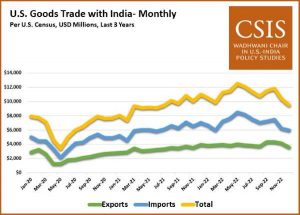
US-India trade talks resume: India and the US held a commercial dialogue last week to discuss issues related to trade and investment. The talk was of great significance not only for the two countries which resumed the dialogue after a gap of three years, but also for world trade which is becoming increasingly protectionist in the wake of present geopolitical uncertainties. The two nations signed a memorandum of understanding on the semiconductor supply and innovation partnership.
There are attempts by the US to decouple its economy from Chinese supply chains with policies like the Chips and Sciences Act and Inflation Reduction Act. India is also following this path through schemes like Production Linked Incentives (PLI).
US-India trade ties: Semiconductors and beyond
The world is currently reeling under a semiconductor chip crisis and countries are chalking out strategies to build resilient supply chains so that they remain unaffected by future disruptions. In fact, 93% of the world’s most advanced semiconductors are produced in Taiwan. The two countries are keen to set up a collaborative mechanism to enhance semiconductor supply chain resilience and diversification.
READ | Clipping the wings: Is India sabotaging its telecom sector
US commerce secretary Gina Raimondo highlighted India’s opportunity to become a part of the entire electronics supply chain, and not just semi-conductors. “India’s desire to expand advanced manufacturing and its presence in the supply chains is totally aligned with the United States’ desire and goal to make our supply chain more resilient,” she said in New Delhi last week.

With the Chips and Sciences Act, the US looks to build a domestic semiconductor industry and push forward America’s scientific supremacy over China. The country is now eager to tie up with New Delhi for semiconductors, US commerce secretary Gina Raimondo said this week. That the US is ready to bet big on India is evident from the fact that Raimondo emphasised that the proposed collaboration will not be just for one year but a 5-10-20 year collaboration. The US is also looking at Indo-Pacific Economic Framework which is expected to be more impactful than a free-trade agreement with New Delhi.
The two countries also look to penetrate each other’s non-mercantile markets such as education and services. The US has been seeking greater access to the Indian education and insurance markets. On the other hand, New Delhi has been pushing for more labour access in some US services. Analysts believe that the two countries may look into striking a standalone services agreement which will benefit both countries with quick opportunities.
This includes US investments in the state-of-the-art GIFT City and on the Indian side, New Delhi may extend fintech innovations like UPI, RuPay, etc. to the US. New Delhi also needs to recognise that the future of trade will be largely led by blocs and both the US and China will be major players in it.
India is the ninth largest trading partner for the US, while the US is India’s largest trading partner and the largest export destination. India and the United States have been long-standing trade partners for decades. However, the trade relations between the two countries have seen their fair share of challenges over the years. As of now, both India and the United States are embroiled in a cold war with China over trade and both look to minimise their dependence on the dragon nation for imports. This presents an opportunity for the two countries to instead strengthen commercial relations with each other.
In 2022, US-India trade in goods stood at $131 billion. Total trade in goods and services is expected to cross $180 billion, the commerce ministry said in a statement. The American nation is also the third biggest source of FDI for India, and the US is one of the top five investment destinations for India. The US-India trade in goods between the two nations has increased to $65.39 billion during April-January this financial year against $62.27 billion a year ago. India received about $5 billion in Foreign Direct Investment (FDI) from the US during April-December 2022-23.
Challenges to India-US ties
The US has also recognised India’s high tariffs on certain components for semiconductors or other electronic products as a major challenge in striking a trade deal. The US commerce secretary also emphasised on difficult foreign investment rules in certain sectors and differences in state-level regulations as major trade barriers between the two nations. Other issues which have stopped them from having a full-fledged trade agreement are divergent views on agriculture, labour standards, climate, and human rights issues.
READ | Take data out of the closet for the well-being of LGBTQ+ people
One of the major challenges in US-India trade ties has been the growing trade deficit between the two countries. The US has consistently recorded a trade deficit with India over the years, which has led to concerns in the United States about job losses and trade imbalances. India, on the other hand, has been critical of the US’s protectionist policies, which have limited India’s exports to the US.
Another significant challenge has been the disagreement over intellectual property rights. The US has been pressuring India to strengthen its intellectual property laws, which would provide greater protection for US companies operating in India. However, India has been hesitant to comply with these demands, arguing that the proposed measures could harm the country’s domestic industry.
However, the US commerce secretary has shown confidence in India stating that one can increase transparency and reduce layers of bureaucracy and regulations at any point of time as it eases the path for more commerce.

